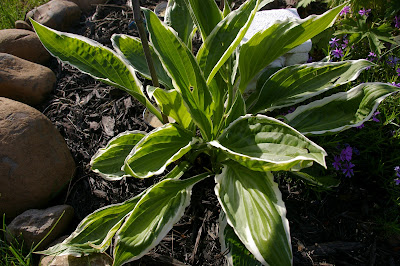 |
| photo taken July 3, 2012 |
Lupinus Polyphyllus
Planted from a packet of seeds from Wilco for $1.99. Pretty good deal. I just sprinkled the seeds and got three little seedlings. Not bad considering I spent $24 for two plants at Tony's Garden Center a month earlier and one of them died as soon as I planted it!
 |
| The lupine that lived! |
Lupines are a member of the legume family.
The "Beans", like in the stalk in the center of the plant bove are edible and are quickly becoming an alternative to soy beans due to their high amino acids and ability to be grown in cooler climates.
Lupins make good companion plants for crops that need significant
amounts of nitrogen in their soil and can be intercropped properly, like
cucumbers, squash, broccoli, and spinach.
Lupines love sandy soil. Since they have long tap-roots they do not transplant well. Full sun to part shade is suitable. Lupines thrive with deep infrequent watering rather than shallow frequent watering.They also may like bi-weekly applications of seaweed meal to increase their nitrogen content. Lupines actually improve the soil they live in.
The commonest color of lupines found in the wild along roadsides are
blues, purples and whites. The variety I have is "Gallery Red" which must be a "Russell" strain since it's a pink/red. The Russell Strain was originally developed through extensive selection and hybridization
around 1935 by George Russell, a railroad crossing guard in Yorkshire, England.
Each blossom on a lupine flower spike is made up of two parts, which can be the same or
different colors, allowing for a wide variety of color variations. Each plant will send up the
same color flowers year after year. Flower spires of established plantings are over a foot long
and after several years plants send up multiple flower spikes resulting in a longer blooming
season. Individual plants usually live from five to twenty years, dropping seeds around them in
early August after June flowering.
Do not mulch lupines for the winter! They do not require mulch as they are very winter hardy
and mice may live in the mulch and gnaw your lupine roots. Hardy from zone 4 (central Maine)
thru Zone 8 (Florida), Lupines thrive on ample moisture. In full sun lupines grow better and
bloom earlier. A cold dormant season produces more prolific flowering.
The quickest and easiest way to
rapidly expand your lupine bed is to save your own seeds, a practice which will yield fifty to
a hundred times more lupine seedlings than by letting nature take its course unaided.
An overview of the process: Gather seed pods, open them when dry, and plant the seeds in
November or March in a nursery bed where they will remain their first year, then transplant
them to their home.
In detail: Cut the entire seed stalk when the seed pods have turned black, but before they
have begun to pop open and curl. Collect these seed stalks in a paper bag, and set them aside
to dry for a month or so. When dry, break the seeds out of the pods, and plant them in a
nursery garden in late fall or early spring. This nursery garden is where the lupines will grow
for their first year, so it is alright if they are spaced closely, say two or three inches
apart. First year lupines are tiny plants, so having many in a small area allows them to be
easily watched over and taken care of. When their second spring arrives, dig each root as the
leaves begin to sprout (late April thru mid May) and plant it where you want it to live. Check
your nursery garden every few days for more roots that have awakened. The lupines will now
grow to large plants and blossom every June.
lupines will benefit by spreading some lime, manure or compost
around the plants in the spring.






































